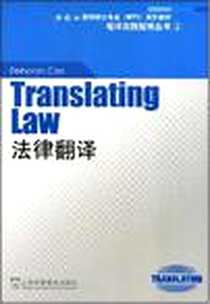《法律翻译》
《法律翻译》
出版时间:2008-7
出版社:上海外语教育出版社
作者:Deborah Cao
页数:189
《法律翻译》内容概要[E]
《法律翻译》是一本指导人们研究和演习法律翻译理论和技巧的力作。该书从语言学、译学以及法学的三维角度,对法律语言的词汇、语用、文体、文化等诸多特征、译者必备的知识技能、翻译过程中应当注意的事项等做了全面深入的阐释,且从语言和文化对比的角度,对法律翻译理论进行了一定的诠释。作为华裔澳人利亚人,该书作者所受的中国教育及其秉承的中华文化精髓使其思维范式和表现技法大有让读者似曾相识之感觉,因而该书非常适合国人之口味。更难能可贵的是该书作者用较为质朴的语言讲述了自己多年从事法律翻译的实践经验,使该书除了较高的理论研究价值外,还具有一定的文本指导作用。
《法律翻译》作者简介[E]
黛博拉·曹,是澳大利亚格里菲思大学社会法律研究中心和语言及语言学学院的成员,翻译学博士,曾任联合国同声传译员。
《法律翻译》书籍目录[E]
ForewordThe Hon. Justice Michael Kirby AC CMGPrefaceAcknowledgements1 Introduction2 Law, Language and Translation Legal Translation Typology The Nature of Legal Language Characterising Legal Language Sources of Difficulty in Legal Translation Legal Translational Equivalence: Possibility and Impossibility3 The Legal Translator Translation Competence and Translation Proficiency A Model of Translation Competence Exploring Translation Competence4 Legal Terminological Issues in Translation Major Terminological Issues Translating Legal Concepts Legal System-bound Usage Ordinary Meaning vs. Legal Meaning Legal Synonyms Linguistic and Legal Uncertainty5 Translating Private Legal Documents Purpose and Status of Translated Private Legal Documents Linguistic Features of Private Legal Documents Differences between the Common Law and Civil Law6 Translating Domestic Legislation Two Types of Translated Domestic Legislation Textual Features of Statutes Pragmatic Feature: Illocutionary Force Other Common Linguistic Features of Legislative Texts Bilingual Statutory Interpretation and Linguistic Uncertainty7 Translating International Legal Instruments International Instruments and their Legal Status Designation of International Instruments Subject Matters Covered by International Instruments Textual Features of International Instruments Verifying Foreign Language Texts in Bilateral Treaty Negotiation Arrangements of Less than Treaty Status Multilingual Instrument Drafting and Translation How the Court Approaches Divergence in Multilingual Law The Use of Translation Technology for Translating Multilingual TextsList of CasesBibliographyIndex
《法律翻译》章节摘录[E]
Translational knowledge structures are assumed to be available in both the SL and TL regardless of in which language the knowledge is acquired. There has not been evidence to conclude in which language knowledge is stored. There is evidence to show, however, that models of the world seem not necessarily to be entirely discrete since knowledge acquired through one language often seems to be available in the other (Ingram and Elias 1974: 70). This study hypothesises that knowledge is stored in the language in which the knowledge is acquired, but it can be retrieved and transferred into the other language through the synthesising process, which is the third area of competence, translational strategic competence. It then can be stored in both languages or one or the other. Further studies are needed for such conjecture or conclusion. The study of the interrelationship between language and thought patterns and the development of bilingualism may provide some insight, but it is clearly beyond the scope of this study.
Under general translational knowledge structures in this model, knowledge of sociocultural background is also assumed, i.e. knowledge of both the SL culture and the TL culture (cf. Snell-Hornby 1988: 34). Translators translate texts, and texts are an integral part of the world around us, invariably embedded in an extralinguistic situation and dependent on their specific social and cultural background (cf. Snell-Hornby 1988). This is in contrast to Neuberts separate sub-competence of cultural competence (1994, 2000).
Translational knowledge structures can be acquired. They are accu- mulative through education and/or experience. Individuals acquire both general structures of the knowledge space of their society and the linguistic expression forms for accessing it (cf. Sager 1993: 42-43) through education. Translators also often acquire knowledge through translating. Translational knowledge structures are flexible, recurring, developmental and networking.
《法律翻译》编辑推荐[E]
该书从语言学、译学以及法学的三维角度,对法律语言的诸多特征、译者必备的知识技能、翻译过程中应当注意的事项等作了较为全面深入的阐释,且从语言和文化对比的视野,对法律翻译理论进行了一定的诠释。可供各大专院校作为教材使用,也可供从事相关工作的人员作为参考用书使用。